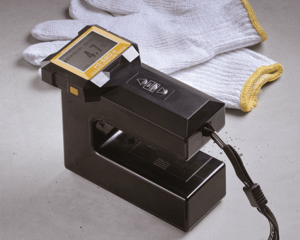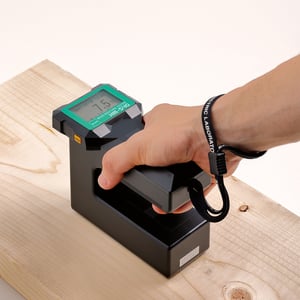 A truck that is hauling freshly felled logs, waiting to be dried and cut into lumber, is hauling almost as much water as it is wood and sometimes it's carrying even more water than wood!
A truck that is hauling freshly felled logs, waiting to be dried and cut into lumber, is hauling almost as much water as it is wood and sometimes it's carrying even more water than wood!
Before it has been dried, approximately half the weight of lumber is made up entirely of its moisture content. Since wood expands and contracts with the amount of moisture it contains, it is vital to select and use wood that has been properly dried.
Why is it important to properly measure and eliminate moisture in freshly-cut lumber? Accuracy! You don’t want to use wood that finishes drying after you cut it, as it may contract as it dries. After all, the old adage of “measure twice, cut once” only works if you can be sure the wood won’t change in size.
Determine Moisture Content
 You can only plan to properly dry fresh lumber if you know its initial moisture content. Using a moisture meter (preferably one made specifically for measuring the moisture in wood) to take multiple readings on each piece of wood, in various locations, will give you an accurate picture of how much moisture is in each piece of lumber, and how the moisture may vary from piece to piece and location to location within the piece of wood. Using a non-destructive (and pinless meter to protect the wood surface) is mandatory to achieve this goal.
You can only plan to properly dry fresh lumber if you know its initial moisture content. Using a moisture meter (preferably one made specifically for measuring the moisture in wood) to take multiple readings on each piece of wood, in various locations, will give you an accurate picture of how much moisture is in each piece of lumber, and how the moisture may vary from piece to piece and location to location within the piece of wood. Using a non-destructive (and pinless meter to protect the wood surface) is mandatory to achieve this goal.
A tree that has just been felled has a moisture content from between 50 and 200%, meaning the tree has twice as much water as wood matter. Most trees have a moisture content of about 75% after they are cut down. Lumber that is dry enough to be usable has a moisture content between 8-10%, which means the drying process is key to producing usable wood.
Removing the Moisture
There are two ways to dry green wood (that is, wood that still needs to be dried): through air drying and kiln drying. When properly executed, drying green wood with a kiln, or just with the air, can produce straight cuts that are not warped at all, which is ideal for construction or woodworking. Improperly dried wood, however, can warp, twist, split, and distort, wasting material and costing you money in the process.
Either by air or by kiln, drying is a slow process. It can take green wood up to several months to completely air-dry enough to be usable. Wood dries from the outside in, and evaporating moisture in the outer rings of the tree is quickly replaced by water from the inner layers. If the outside dries too quickly? The outer layers shrink around the inner layers, locking in moisture, which can cause major problems for the lumber later on.
The drying process has to be carefully regulated and its original moisture content must be factored into the speed and drying times of the lumber that needs to be dried.
Kiln Drying
Smaller cuts of wood can prevent unwanted distortions from happening, but larger issues with drying can also be prevented by using a kiln for complete control. Professional kilns have regulated schedules for each kind of lumber and tree species to ensure timely drying times while still producing great results. The key to success in air-drying and kiln-drying wood is to factor in the lumber’s composition and initial moisture content.
Interested in kiln drying your own lumber? There’s all kinds of information available about how to create your own solar kiln, right in your own backyard. Don’t forget though: take constant moisture readings!
Air Drying
The process of air-drying wood is an exact science. The wood needs to dry in a proper location, and it can be sealed with an anti-stain sealant. Then cuts of lumber are stacked between “stickers,” or strips of wood that separate the layers of lumber and allow air to flow freely between them. In addition, there are all kinds of tricks to prevent warping and staining.
Drying times, thickness of cuts, and species of tree all factor into how lumber should be air-dried, but again, taking constant, accurate readings with a moisture meter is key.
Want to know more about how a wood moisture meter can impact your woodworking or your construction? At Kett, we care about our products and want to ensure you are as happy with your moisture meters as we are.
Contact us today or learn more about our wood moisture testers and let us help you find the perfect moisture meter for your needs.


